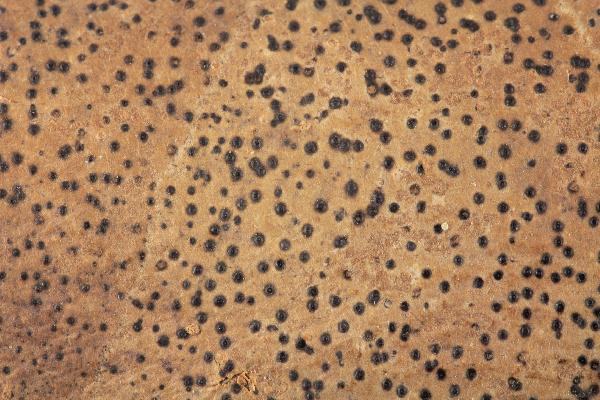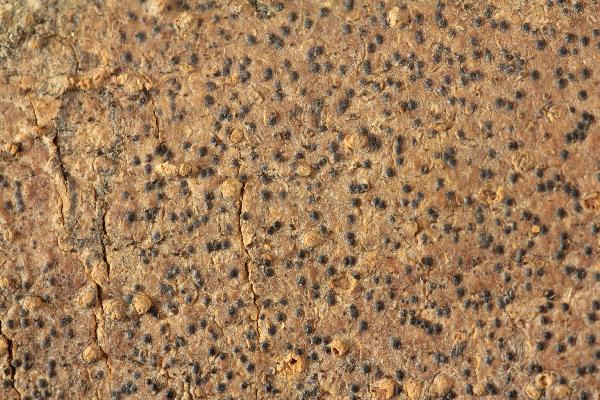Naetrocymbe fraxini (A. Massal.) R.C. Harris
More Florida Lichens: 62, 1995. Basionym: Arthopyrenia fraxini A. Massal. - Ric. Auton. Lich. Crost.: 167, 1852.
Synonyms: Arthopyrenia fraxini f. orbicularis A. Massal.; Arthopyrenia fraxini f. rufidula A. Massal.; Arthopyrenia megalospora Lönnr.; Arthopyrenia persoonii var. fraxini (A. Massal.) A. Massal.; Arthopyrenia punctiformis var. fraxini (A. Massal.) Anzi; Leiophloea punctiformis var. orbicularis (A. Massal.) Trevis.; Pyrenula fraxini (A. Massal.) Trevis.; Spermatodium malitiosum var. fraxinicola Trevis.; Verrucaria epidermidis var. fraxini (A. Massal.) Garov.
Distribution: N - VG, Ven (Lazzarin 2000), TAA (Nascimbene & al. 2007b), Lomb (Nascimbene & al. 2021), Piem (Isocrono & al. 2004, 2005b), Emil (Fariselli & al. 2020), Lig. C - Tosc, Marc (Nimis & Tretiach 1999), Umb (Herb. Ravera 4411), Laz (Nimis & Tretiach 2004), Sar. S - Camp (Garofalo & al. 2010), Bas, Cal (Puntillo 1996), Si.
Description: Thallus crustose, inconspicuous, or visible as a pale brown patch on the bark, non-lichenized. Perithecia black, circular or ellipsoid in outline, 0.25-0.5 x 0.2-0.4 mm. Involucrellum dimidiate, brown both in water and in K, of compacted hyphae and bark cells; exciple thin, usually colourless, surrounding the centrum; pseudoparaphyses short- and broad-celled, 1-1.5 μm thick, richly branched, not moniliform, the cells 6-12 μm long; downwardly projecting periphysoids present near the ostiole. Asci 8-spored, obpyriform, fissitunicate, with two functional wall layers, with a distinctive apical region lacking a nasse, 60-90(-100) x 13-25 μm. Ascospores 1(-3)-septate, with more or less unequal cells, more or less constricted at septa, the apices rounded, (17-)19-26 x (4.5-)5-7 μm, with a distinct, 1-1.5 μm thick (in K) gelatinous perispore. Pycnidia black, c. 0.1 mm across. Conidia hyaline, bacilliform, 4-6 x c. 0.8 μm. Photobiont absent. Spot tests: thallus K-, C-, KC-, P-, UV-. Chemistry: without lichen substances.Note: a mild-temperate species found on smooth bark of (mostly) deciduous trees; most probably non-lichenised.
Growth form: Fungus
Substrata: bark
Reproductive strategy: mainly sexual
Pioneer species
Commonnes-rarity: (info)
Alpine belt: absent
Subalpine belt: absent
Oromediterranean belt: absent
Montane belt: very rare
Submediterranean belt: rather common
Padanian area: very rare
Humid submediterranean belt: rather common
Humid mediterranean belt: rare
Dry mediterranean belt: absent

Predictive model
Herbarium samples

Photo uploaded by P. Cannon - CC BY-SA NC - Source: http://fungi.myspecies.info/all-fungi/naetrocymbe-fraxini


P.L. Nimis; Owner: Department of Life Sciences, University of Trieste
Herbarium: TSB (32489)
2003/03/12

Collezione lichenologica Abramo Massalongo del Museo di Storia Naturale G. Ligabue di Venezia - Autori: Seggi, Linda; Trabucco, Raffaella Proprietà: Fondazione Musei Civici di Venezia - CC BY-NC
ad fraxinos
as Arthopyrenia fraxini

Collezione lichenologica Abramo Massalongo del Museo di Storia Naturale G. Ligabue di Venezia - Autori: Seggi, Linda; Trabucco, Raffaella Proprietà: Fondazione Musei Civici di Venezia - CC BY-NC
Italy, Veneto, Ad Fraxinos in opp. Tregnago 1855
as Arthopyrenia fraxini
Growth form: Fungus
Substrata: bark
Reproductive strategy: mainly sexual
Pioneer species
Commonnes-rarity: (info)
Alpine belt: absent
Subalpine belt: absent
Oromediterranean belt: absent
Montane belt: very rare
Submediterranean belt: rather common
Padanian area: very rare
Humid submediterranean belt: rather common
Humid mediterranean belt: rare
Dry mediterranean belt: absent

Predictive model
| Herbarium samples |

Photo uploaded by P. Cannon - CC BY-SA NC - Source: http://fungi.myspecies.info/all-fungi/naetrocymbe-fraxini


P.L. Nimis; Owner: Department of Life Sciences, University of Trieste
Herbarium: TSB (32489)
2003/03/12

Collezione lichenologica Abramo Massalongo del Museo di Storia Naturale G. Ligabue di Venezia - Autori: Seggi, Linda; Trabucco, Raffaella Proprietà: Fondazione Musei Civici di Venezia - CC BY-NC
ad fraxinos
as Arthopyrenia fraxini

 INDEX FUNGORUM
INDEX FUNGORUM
 GBIF
GBIF
 DOLICHENS
DOLICHENS





